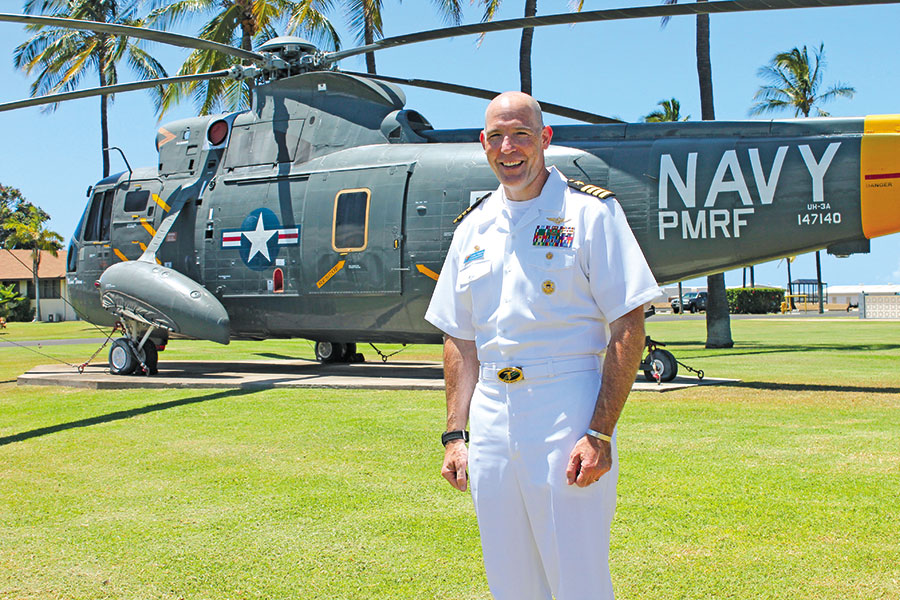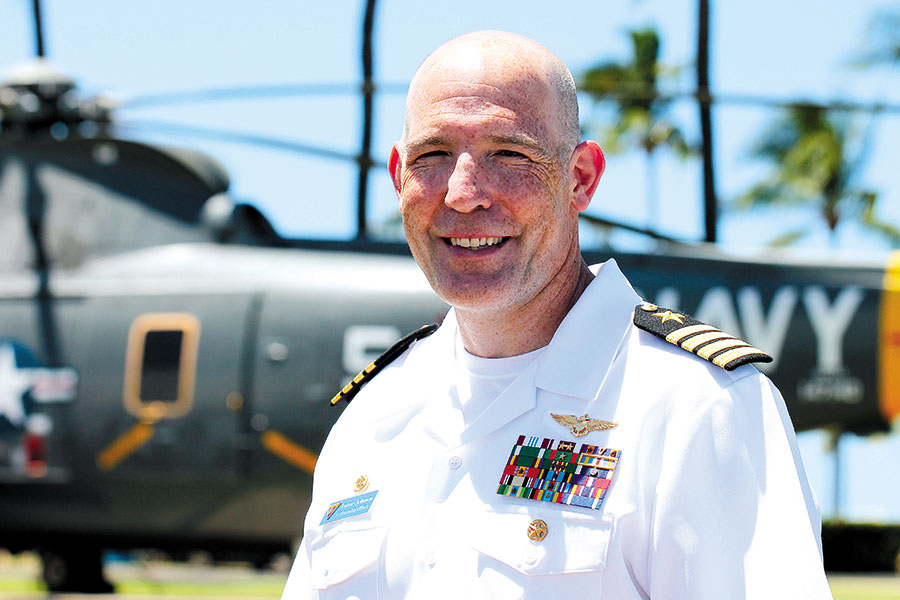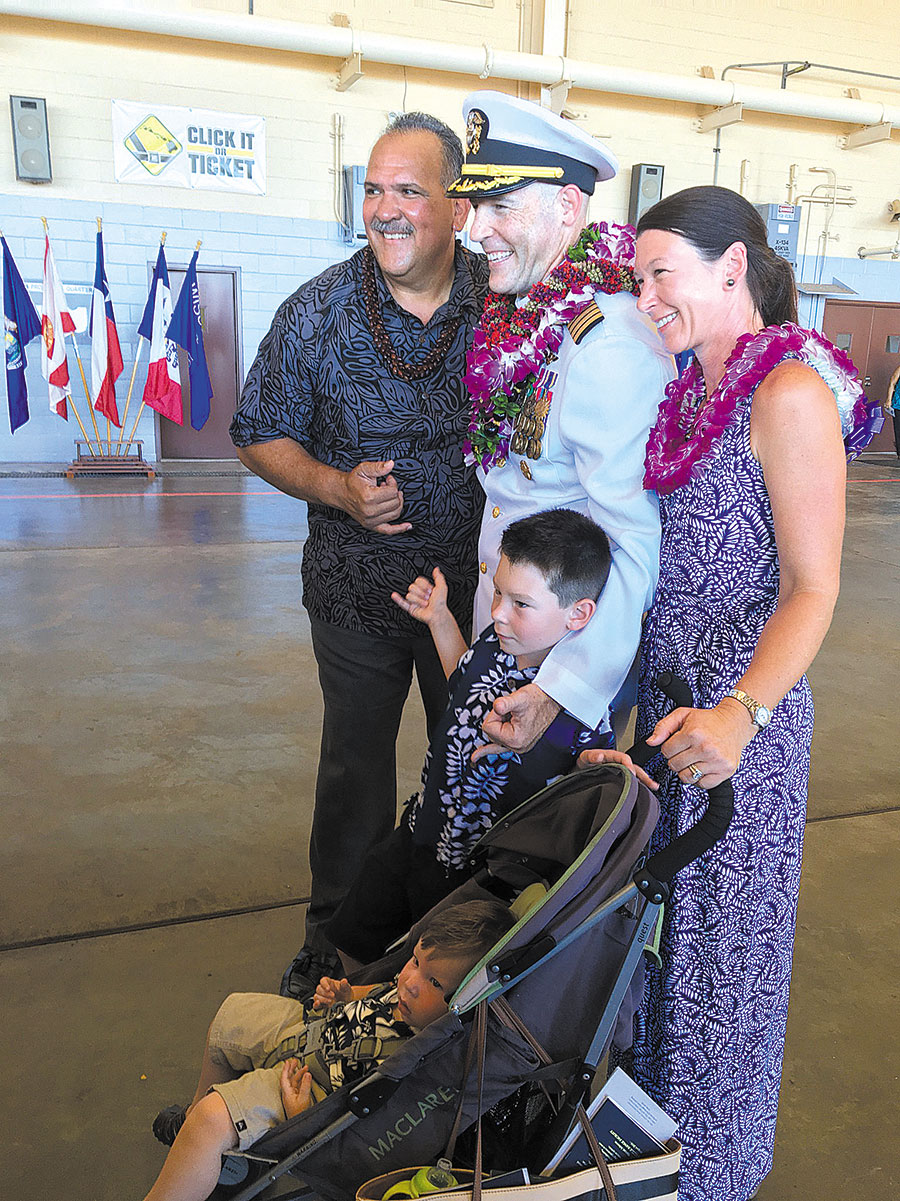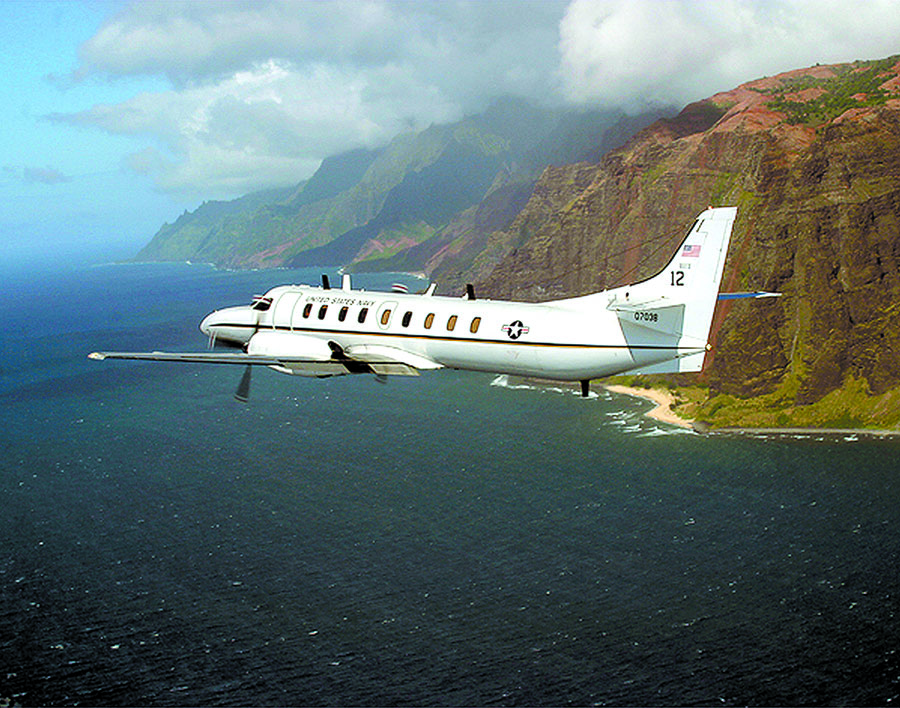Flights to Whites

Naval aviator Capt. Vincent R. Johnson takes off as commanding officer at Pacific Missile Range Facility, Barking Sands. Photo: Coco Zickos
A couple of naval aviators in flight suits walk through the airport hangar at Pacific Missile Range Facility. They’re getting ready to embark on a flight in a C-26 aircraft. It’s like stepping into a scene from Top Gun — a movie that happened to be one of Capt. Vincent R. Johnson’s favorites as a teen. The naval aviator is standing here today as PMRF’s new commanding officer, watching the young men follow in his footsteps.
“Flying always seemed like fun,” he says.
He gazes longingly at the pilots about to take off, expressing how he wishes he could join them. Johnson only has been in his position a little more than a month, and by the time this article is published, he will have made his inaugural Kauai flight.
“It’s really easy to forget about the bad days because there are so many good days in comparison,” he says about flying.

Naval aviator Capt. Vincent R. Johnson takes off as commanding officer at Pacific Missile Range Facility, Barking Sands. Photo: Coco Zickos
Since graduating from the U.S. Naval Academy with a commission and a B.A. in physics, as well as earning an M.A. in national security and strategic studies from U.S. Naval War College and becoming a naval aviator in 1996, he has logged more than 3,100 flight hours — some on aircraft traveling faster than the speed of sound. But it’s taking off from an aircraft carrier with a landing space of only some 700-800 feet that has been the most exhilarating. “At night, it can also be one of the most terrifying things,” he says.
Born in Wisconsin and raised in Michigan, Johnson has flown helicopters and aircraft such as the EA-6B Prowler, as well as jets akin to the Blue Angels.
“At the end of the day,” he says, “I just like flying.”
These days, however, he’s mostly swapped his flight suit for his “whites,” which he says he’s worn more in the past month than he had in the last decade during his time serving in the U.S. Navy.
Now he’s responsible for the largest instrumented testing and training range in the world at PMRF, Barking Sands, with roughly 2.1 million square miles of land, sea and air, including some 1,100 square miles underwater. “‘Missile range’ doesn’t do justice to everything that happens here,” he says.
Besides regular training and testing, as well as helping host RIMPAC every two years, in order to aid the nation’s security, new state-of-the-art equipment, such as the SPY-6 (V), the next generation of air and missile defense radar, is evaluated at the base. “It’s all ‘science fair project’ kind of things,” explains Johnson, who was a military professor of strategy and policy at Naval War College in Rhode Island prior to moving here. “It’s kind of fun; it keeps us busy.”
Being in charge of some 1,000 people — nearly 90 active-duty military who live on base, approximately 160 civilians and more than 700 contractors — keeps his days full. One of his most important activities these days, however, is continuing to dispel myths and misinformation associated with the base, something his predecessor, Capt. Bruce Hay, initiated before retiring in August. Johnson plans to offer even more public events at PMRF, including free concerts, and would like more people to apply for a yearly guest pass.
He also encourages the public to ask questions about topics such as sonar and whales.
“I think we sometimes get a bad rap,” says Johnson. “The Navy, in general, is very conscious of marine mammals and whales — any kind of mammal, we will stop an exercise once it’s been sighted.”
Recently released studies by scientists through the Obama administration have, in fact, confirmed that the rise of commercial shipping traffic is the largest conductor of noise in the ocean, not the U.S. Navy.

Mayor Carvalho welcomes Capt. Vincent R. Johnson, wife Marcia and children Henry and Sam. PHOTO COURTESY PMRF
Additionally, PMRF’s underwater range contains hydrophones that allow it to track the movement of Hawaiian humpback whales, which lets sailors tailor training around their activity.
“And we actually can talk to them,” says Johnson, who cites a sailor who has been working on Kauai for a number of years, who claims he can convince the whales to come over and talk to him using the sound system. “So we’re aware,” he says.
The U.S. Navy also is aware of other environmental concerns, and, for instance, it has technology that Johnson would like to introduce to the island to help mitigate the amount of garbage that ends up in landfills.
“If you could reduce what you’re putting into the land-fill, you wouldn’t need to look at a new landfill so soon,” says Johnson.
He’s excited to be an integral part of the community by becoming more involved in issues like this. He’s also looking forward to participating in the plethora of outdoor activities, like fishing, camping, paddleboarding and mountain biking, the island has to offer, as he knows he won’t be brought “fully into the fold” until he starts getting the scoop on some of Kauai’s hot spots, like best places to fish.
He’s already spent some time at Polihale with wife Marcia and their two children, Henry (a first-grader at St. Theresa) and Sam (17 months). “I can’t think of a better place to raise kids,” says Johnson, who was part of the World Famous Black Ravens of VAQ-135 in 2009, and deployed in support of Operation Enduring Freedom with Carrier Air Wing Eleven and USS Nimitz.
So don’t be surprised if you find him on a beach somewhere with his family. He might even be playing the ukulele he swapped his guitar for after participating in RIMPAC 2012.
Even so, Johnson knows his time on the island is limited.
“We’re the ones who come here, fall in love with the place and just when we’re getting used to it, the Navy’s telling us we have to go somewhere else.”
cocomidweek@gmail.com





